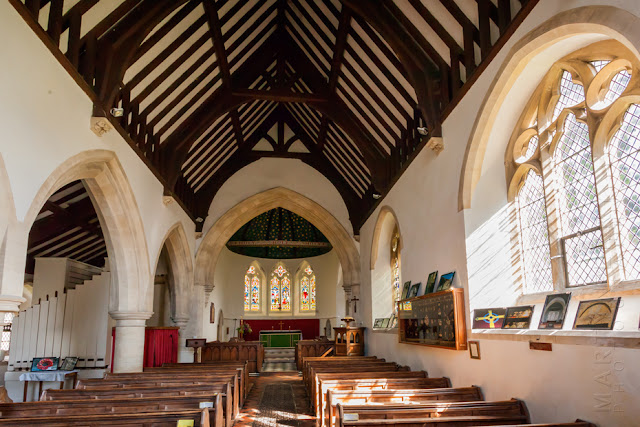The village of Filkins is actually two villages, as sat right next to it is Broughton Poggs, officially the small Broadwell brook marks the boundary separating the two villages, but in reality, you can walk from one to the other and not know it. Broughton Poggs doesn't actually have any roads that lead into the village, so you could only walk to it.
| Looking along one of the quiet lanes that run through the village. |
Filkins and Broughton Poggs straddle what has always been an important north-south route from the high Cotswolds to the Thames, and beyond to the South Coast. No doubt the easy availability of good water from the many local springs led to early settlemen there. ‘Filkins’ roughly translates as the meadow of Filica, a Saxon nobleman perhaps from the Hwicce tribe, from which is derived ‘Wychwood’, the ancient forest around Burford. The Filkins ‘s’ is possibly an allusion to the traditional division of the village into Upper and Nether Filkin.
| With the lack of traffic it's easy to imagine the village as it was in times gone by. |
At the beginning of the 18th century, most of the parish was owned by George Hamilton, the 6th Earl of Orkney. Hamilton’s wife, an ex-mistress of William III, was one of the great hostesses of her age, and a formidable woman. Jonathan Swift remarked that ‘she squinteth like a dragon’. Hamilton himself was one of Marlborough’s generals at the Battle of Blenheim.
Broughton has it's own manor house, which has had a few 'colourful' owners. During the 16th century it was included with lands given to Ann of Cleves on her divorce from Henry VIII. Then there was ‘a gentleman named Cresswell’ who bought the hall and promoted boxing tournaments on the lawn. He invited well-known pugilists of the day to show off their skills against unwilling villagers who happened, in their misfortune, to be passing. George Swinford tells of a later Squire Hardcastle who, in the early years of the 20th century, bought himself ‘a new fangled motor-car at the age of 91.’
| The back of St Peter's church, the front can be seen at the top of the page. |
St Peter’s, Filkins (Broughton Poggs also has a church called St Peter's) was built in Victorian Gothic style in 1855 - 57 by George Edmund Street, who went on to build the Law Courts in the Strand, London.
 |
| The bright and airy church interior, thanks to the latest technology in glass making at the time. |
Filkins was originally part of Broadwell parish and given by Ralph de Limesi of Broadwell to the Knights Templar soon after 1185. When the Templars fell from grace, 1307 -1314, Filkins remained a farming area of small freeholders.
| It has the look of much more modern church inside, but still retains plenty of historical character. |
John Betjeman described the church as 'simple and subtle in local stone'. This was the period of the Arts and Crafts movement and William Morris was engaged to produce designs for the church glass. He is buried in the nearby churchyard of Kelmscott.
| Swinford Museum. |
One of Oxfordshire’s oldest and smallest rural museums, Swinford Museum occupies a 17th-century cottage and stands alongside the former village lock-up. It has a fine collection of local domestic, agricultural, trade and craft tools providing a unique picture of a bygone rural community.
| Home of the Cotswold Woollen Weavers. |
Set in 18th century buildings the Cotswold Woolen Weavers uses the wool of the Cotswold Lion. For 500 years these sheep created the rolling Cotswold landscape, and money from their wool enabled the building of the grand Wool Churches, manor houses and countless Cotswold cottages.
The working mill turns fleece into fabric using the age-old craft and machinery to produce garments and cloth for sale in the mill shop. Considering it's ubiquitous presence in the area, it somewhat surprising to learn that today, there is not much more than a ton or two of Cotswold fleece-wool available each year.
| The Five Alls pub, which was closed for a number of years, before being re-opened in 2012. |
The Five Alls is a traditional 18th century English coaching inn, even the name itself is rich with tradition, referring to the monarch (who rules all), the lawyer (pleads for all), the priest (prays for all), the soldier (fights for all) and the peasant (works for all).
And that is the little village of Filkins, next time we take a short trip to the resting place of William Morris, when we visit Kelmscott.
You can see more images from the beautiful Cotswolds countryside on my website.

No comments:
Post a Comment